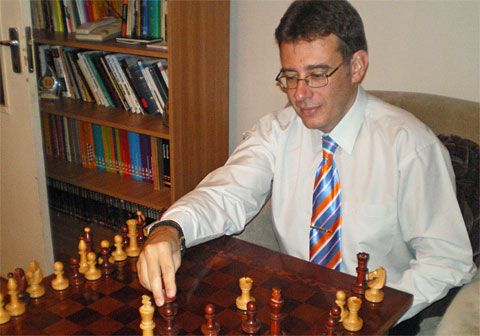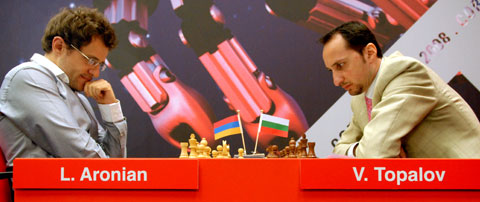Wijk aan Zee 2008

GM Mihail Marin in his analysis kitchen at home in Romania
The following express commentary was provided by Romanian grandmaster Mihail
Marin, who is the author of a number of very popular ChessBase
training CDs and articles for ChessBase Magazine. GM Marin will study the games
of the World Championship tournament in much greater detail and provide the
full results of his analysis in the next issue of ChessBase
Magazine.
Round one commentary by GM Mihail Marin
We can divide the games of the first round into two categories: three hard-fought
decisive games and four strategically interesting, but basically short draws.
Playing with black, Anand could not find an effective antidote to Radjabov's
apparently inoffensive novelty in the Semi Slav. White obtained an overwhelming
advantage, but then "only" managed to convert it into the win of an
exchange. The World Champion put up heroic resistance, but overlooked a threefold
repetition and had to resign after 85 moves anyway.
Aronian employed an original setup against Topalov's Grünfeld (!) defence.
Topalov reacted actively and, uncharacteristically for him, won the exchange
in a position with reasonable compensation for White. Later, he treated the
position too optimistically and gradually went down. Aronian won in 62 moves.
Carlsen played a good Sicilian with Black against Mamedyarov, gradually increasing
his queenside pressure. Before the first time control, play took a casual course,
while the final result (0-1) remains clouded by some mystery.
Kramnik-Van Wely saw frequent and sometimes unexpected structural modifications,
but players probably considered that the mutual weaknesses compensate for eachother
when agreeing on a draw on move 25.
Playing with black against Eljanov, Leko treated the position with hanging pawns
in the standard way. He built up his pressure against the d4-square, culminating
with gneral exchanges and a logical draw.
In a position characterized by similar structure, Judit Polgar preferred to
refrain from ...c5 at all and managed to obtaine a stable blockade in the centre,
compensating for Ivanchuk's pair of bishops.
In the shortest game of the first day, it took Gelfand just a couple of accurate
defensive moves to repell Adams' attacking attempts in a fashionable line of
the Petroff.

The playing hall of the De Moriaan – the GM groups are in the back
of the picture

Top encounter of the day: Teimour Radjabov vs Viswanathan Anand
Radjabov,T (2735) - Anand,V (2799) [D43]
Corus A Wijk aan Zee NED (1), 12.01.2008 [Mihail Marin]
1.d4 d5 2.c4 c6 3.Nc3 Nf6 4.Nf3 e6 5.Bg5 h6 6.Bh4 dxc4 7.e4 g5 8.Bg3 b5
9.Be2 Bb7 10.0-0 Nbd7 11.Ne5 Bg7 12.Nxd7 Nxd7 13.Bd6 a6
14.Re1!? This modestly looking developing move is a novelty. White usually
advances one of his a-, d-, or e-pawns here. 14...Bf8 15.Bg3 Bg7 16.Bd6

Anand contemplating what he should do after 16.Bd6
16...Bf8 17.Bxf8 Rxf8 18.b3 b4 19.Na4 c3
20.a3. Now that he has made significant progress on the scale of development
(he only needs to connect rooks, while Black has lost the right to castle and
faces problems of coordination), White finally starts advancing all the aforementioned
pawns. 20...a5 21.d5 Qe7 22.d6 Qf6 23.e5. White has achieved huge advance
of space with shocking ease. The e5-pawn is taboo, because the knight has to
guard the c5-square while the queen cannot expose herself to discovered attacks
such as Ba6. Here we can see that Re1 is not as inocent as it might have looked
a couple of moves ago. We can state that the novelty has been quite successful.
23...Qf4 24.Bd3 bxa3 25.Qe2 Qd2 26.Rxa3 Qxe2 27.Rxe2 g4
Anand designes a plan to eliminate the e5-pawn, but this will increae the chaos
reigning in his camp. 28.Nxc3 Rg8 29.Ne4 Kd8 30.Nd2 c5 31.Bb5 Bd5 32.Nc4
Rg5 33.Rea2 Nxe5
Black has achieved his partial aim, but White launches a very powerful attack
in mutual time trouble. 34.Nb6 Rb8 35.Rxa5 Be4 36.Ra7 f6
37.R2a6. Black's rather shaky defence relies mainly on the strong centralized
knight. Therefore, White should try to exchange it. This would have been a good
moment to try accomplishing that with 37.Nd7 , because after 37...Rxb5 38.Nxf6
the threat Ra8!+ followed by mate wins the bishop back, after having spoiled
Black's structure. 37...Rg8 38.Rc7. Here, he could have prepared Nd7
with 38.Ba4. 38...Rf8 39.Rxc5 Rf7 40.d7 Nxd7 41.Nxd7 Rxd7 42.Bxd7 Kxd7 43.Rc3
Compared with the position he had, White has achieved relatively little. Black's
better structure offer him chances to resist for a long time. However, Radjabov
dealt with the technical part quite well. 43...f5 44.Ra7+ Kd6 45.Rh7 Bd5
46.Rxh6 Bxb3 47.h3 gxh3 48.Rhxh3
Now, Black's structural advantage has vanished, but the reduced number of pawns
and the bishop's stability in the centre still offers him some hope. 48...Bd5
49.Rc2 Ke5 50.f3 Kf6 51.Kf2 Rb4 52.Re2 Kg6 53.Kg3 Ra4 54.Rh4 Ra7 55.Rb2 Kf6
56.Rhb4 Ke5 57.Re2+ Kf6 58.Rd2 Ke5 59.Re2+ Kf6 60.Kf4 Ra3 61.Rd2 Ra5 62.Re2
Ra3 63.Kg3
63...Ra8? If I am not mistaken Anand could have claimed a draw by repetition
by playing 63.Ra7! The same position occurs after 57...Kf6 and 59...Kf6.
64.Rc2
Ke5 65.Rh4 Rg8+ 66.Kh2 Ra8 67.Re2+ Kf6 68.f4 Ke7 69.Rh7+ Kd6 70.Kg3 Rg8+
71.Kh3 Rg4 72.g3 Rg8 73.Rd2 Rc8 74.Kh4 Rc3 75.Rg7 Ra3 76.Rc2 Bc6 77.Rc1 Rb3 78.Rg1
Bd5 79.Kg5 Kc5 80.Kf6 Kd4 81.Re1 Rb6 82.Rd7 Rc6 83.Ke7 Ra6 84.Rd6 Ra7+ 85.Kf6
White will soon sacrifice the exchange on e6, with a won rook ending. 1-0.
[Click to replay]

Mamedyarov,S (2760) - Carlsen,M (2733) [B50]
Corus A Wijk aan Zee NED (1), 12.01.2008 [Mihail Marin]
1.e4 c5 2.Nf3 Nc6 3.Nc3 g6 4.g3 Bg7 5.Bg2
This is a rather unambitious form of the Closed Sicilian. Once he has played
Nc3, White usually develops his king's knight after advancing the f-pawn. Or,
if he plays Nf3 in front of the pawn, Nbd2 is usually preferred, in order to
be able to cover the d4-square with an eventual c3. 5...d6 6.0-0 Bg4 7.h3
Bxf3 8.Qxf3 Nf6 9.d3 0-0
10.Qd1. Here we can see a first difference induced by White's modest
setup. With his pawn on f4 already, White would retreat with his queen only
in case of ...Nd4. In the game, Black will use his queen's knight for more concrete
purposes. 10...Nd7 11.f4 c4! Breaking White's compact structure with
such economy of means is an important achievment for Black, who has excellent
counterplay now. 12.dxc4 Na5 13.Nd5 Nxc4 14.c3 Ndb6 15.Qe2 Rc8 16.Kh2 e6
17.Nb4 Na4
Black has strong pressure on the queenside, while on the opposite wing White's
chances for an attack are at least questionable. 18.f5 Re8 19.fxe6 fxe6 20.Nd3
Qb6 21.h4 Qa6 22.Rf2 Ne5 23.Nf4
Black has achieved excellent stability on dark squares, which is one of the
secret dreams of any Sicilian-player. The position remains balanced, but Black's
play seems easier to be carried out. 23...Nc5!? 24.Qxa6 bxa6 25.Re2 h6 26.Kh1
a5 27.Be3 a4 28.Rd1 Rc6 29.Bd4 g5 30.Nh3 g4 31.Nf4 Rb6 32.Nh5 Bh8 33.Red2 Reb8.
Black's queenside pressure has become unbearable. White decides to start
his counterplay along the d-file, but this will imply a significant strategic
concession, the exchange of his dark-squared bishop. 34.Bxc5?! dxc5 35.Rd8+
Kf7 36.Rxb8 Rxb8 37.Rd2
37...Nc4?! Black allows his opponent "undeserved" counterplay.
The prophylactic 37...Ke7 , threatening ...Nc4 would have offered Black a clear
advantage. If White covers the c4-square with 38.Bf1, the f3-square would remain
undefended, allowing Black obtain decisive initiative with 38...a3 39.b3 c4
40.b4 a5 41.bxa5 Nf3 All Black's pieces are on attacking positions, while the
white forces lack coordination and are exposed to the double attacks of the
knight. 38.Rd7+ Ke8 39.Rxa7 Be5 40.Rxa4 Ne3
White's decision to resign looks at least premature. I admit, his position
does not look too appealing, but... nobody has ever improved his situation by
resigning. Both players were probably convinced that the g2-bishop will be lost
soon, but this is more of an illusion. After 41.b3 Rd8 White has 42.Kg1 Rd2
43.Bh1 when he is very much alive yet.
Analysis diagram
Things would change if the black king could be activated quickly via g6 (and if
Nf4, then ...Bxf4 gxf4 and ...Kxh4), but after 43...Kf7 White can question the
stability of the enemy bishop with 44.Ra5 . Otherwise, White would play 44.Ra7,
cutting the enemy king away and intending to advance of the a-pawn as far as he
can, or exchange the dominating bishop with Ng7.
0-1. [Click
to replay]

Premature resignation? Shakhryar Mamedyarov

Aronian,L (2739) - Topalov,V (2780) [D71]
Corus A Wijk aan Zee NED (1), 12.01.2008 [Mihail Marin]
1.d4 Nf6 2.c4 g6 3.Nc3 Bg7 4.g3
An old-fashioned move order. 4...d5. This is supposed to be a good moment
to transpose to the Grünfeld, but this opening is not supposed to be one of
Topalov's specialties with Black. 5.cxd5 Nxd5 6.Bg2
6...Nb6. Now, everything transposes to oficially approved lines. Several
decades ago, intense theoretical discussions were held in the variation 6...Nxc3
7.bxc3 c5 8.e3 Nc6 9.Ne2. The conclusion was that Black has easy play. It is
relevant that Viktor Kortschnoj, who was winning like a machine most of his
fianchetto KI games in those remote years, abandoned the setup precisely because
of this variation. It is refreshing to see that a leading player like Aronian
resorts to such well-forgotten lines. 7.Nf3

Veselin Topalov ponders his seventh move
7...Nc6 8.Bf4 0-0
9.e3!? But now we embark a very original course again. Usually, White
consolidates his centre with his bishop on c1. On f4, the bishop is more active,
but alse oxposed to such brutal attacks like ...g5. 9...h6 10.h4 Bg4 11.Rc1
As usual in the Grünfeld, Black has comfortable development, but if he will
not find a way to break White's centre, he will slowly fall into a passive position.
11...e5! 12.dxe5 Qe7 13.Nd5 Nxd5 14.Qxd5 Nb4. The tactical operation
initiated by this move will result in winning the exchange for Black. However,
White will retain entirely adequate compensation. Besides, if we take into account
the fact that Topalov is famous for sacrificing the exchange himself quite frequently,
one wonders whether he felt comfortably with his "achievement" from
psychologic point of view. In any case, 14...Bxf3 , eliminating a defender of
the e5-pawn, would not have promissed Black easy life, for instance 15.Bxf3
Analysis diagram
15...g5 (In fact, this move has some unpleasant psychological background
for Topalov, too. In WaZ 2005, he lost the f4-bishop against Judit, after trapping
his own bishop with e3, but ulterior analysis proved that he could have drawn
anyway. Here, the move is simply risky, but 15...Nxe5 16.Bxe5 Bxe5 17.Qxb7
Rab8 18.Qxa7 Rxb2 19.0-0 leaves Black a pawn down, with just chances for
a draw, in view of the presence of opposite coloured bishops.) 16.hxg5
hxg5 17.Qe4 Rfd8 18.Ke2 followed by Rcg1 and Rh5, eventually forcing Black to
open the g-file with a strong centralized position and a powerful attack for
White. 15.Qc4 Be6 16.Qxc7 Nd3+ 17.Kd2 Qb4+ 18.Qc3 Qxc3+ 19.Rxc3 Nxf2 20.Nd4
Nxh1 21.Bxh1
White is better developed and retains big part of his central groupment of
pawns and pieces. The loss of the f2-pawn is more of aesthetic importance. The
posiiton is fairly balanced, but Topalov will play too obstinately for an ilusory
attack, which will eventually leave White on top. 21...Rfd8 22.Rc7 Rac8 23.Rxb7
Bxa2 24.Rxa7
24...Be6. Now or later, ...Bd5 would absolve Black from the danger of
losing. Topalov decides to keep the bishop for his attacking purposes... 25.Rb7
Bf5 26.Bf3 Rc2+ 27.Ke1 Rc1+ 28.Kf2 Be6 29.g4. It has become clear now that
the white king feels secure surrounded by his guards, while Black's rooks lack
coordination. 29...Bc8 30.Rb8 Rf8 31.h5 g5 32.Bg3 Ra1 33.Rb6 Re8 34.Be2
34...Bxe5. I have the feeling that this pawn exchange favours White,
because the g5-pawn will become rather weak. 35.Bxe5 Rxe5 36.Rxh6 Re4 37.Bf3
Re5 38.Rc6 Be6 39.Nxe6 fxe6 40.Be2. The position has changed a lot over
the past 20 moves, but Black's rooks still look completely inoffensive. 40...Rb1
41.Rb6 Rd5?! Blundering away the entire kingside structure. 42.Bc4 Rd2+
43.Kf3 Rbxb2 44.Rxe6 Rbc2 45.Rg6+ Kh8 46.Be6 Rc6
47.Ke4. The start of the decisive invasion. 47...Rd8 48.Kf5 Rc5+
49.Kf6 Rf8+ 50.Ke7 Rf3 51.Bf5 Re5+ 52.Kf7 Rfxf5+ 53.gxf5 Rxf5+ 54.Ke6 Ra5 55.e4
Kh7 56.e5 Ra1 57.Rxg5 Kh6 58.Rg2 Kxh5
Not all rook endings are drawn. Sorry, Salviely. 59.Kf6 Rf1+ 60.Ke7 Ra1
61.e6 Kh6 62.Kf7 1-0. [Click
to replay]
All pictures by


























































